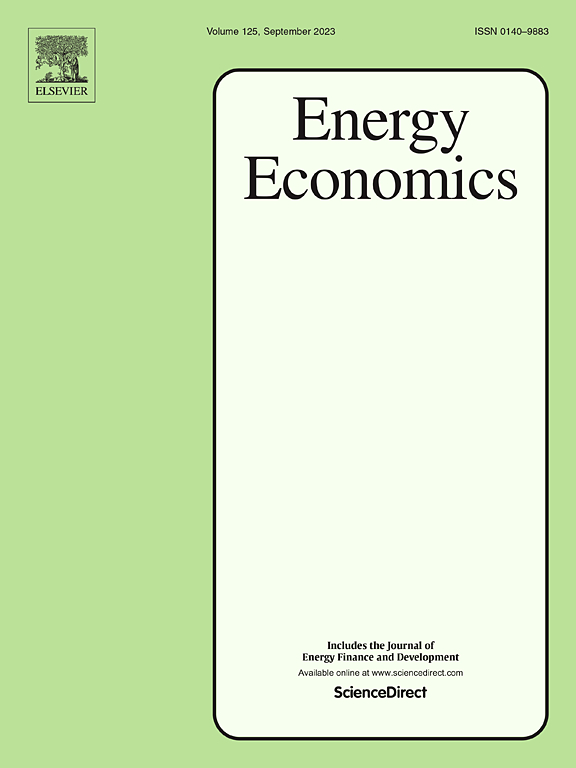Mechanism of symbiotic interaction in the recycled cement industry chain under the Chinese certified emission reduction scheme
IF 14.2
2区 经济学
Q1 ECONOMICS
引用次数: 0
Abstract
Overreliance on fossil energy drives carbon emissions, exacerbating climate change. The symbiosis model of the recycled cement industry chain (RCIC) under the Chinese Certified Emission Reduction (CCER) scheme offers an innovative solution to the energy-intensive emission bottleneck of traditional cement production. However, existing research lacks an analysis of the dynamic process of strategic interaction and symbiotic evolution among enterprises in the RCIC, and the mechanism of symbiotic evolution in the RCIC remains unclear. To reveal the symbiotic evolution mechanism of the RCIC, this study constructs a tripartite evolutionary game model of construction enterprises, recycled cement enterprises and traditional cement enterprises on the basis of industrial symbiosis theory. In addition, based on industry reports, publicly available data from the Chinese carbon trading market, and existing research, this study conducted numerical simulation analysis of key parameters through the integration of multiple data sources and parameter calibration. The study found: (1) The symbiosis profit distribution coefficient has a heterogeneous effect on the behavior of the main body in the RCIC. (2) The symbiosis coefficient positively influences the symbiotic evolution of the RCIC. (3) The CCER price within a reasonable range will promote the formation of stable symbiotic relationships. The conclusions of this study passed sensitivity tests, incorporated the CCER mechanism into the symbiosis analysis of the RCIC for the first time, and constructed a new model applicable to the symbiosis scenario of the waste treatment industry. At the same time, this study provides a basis for decision-making on symbiosis benefit distribution strategies for enterprises and provides a reference for the government to formulate effective CCER policies for the resource utilization of construction and demolition waste.

中国认证减排方案下再生水泥产业链共生互动机制
对化石能源的过度依赖导致了碳排放,加剧了气候变化。中国认证减排(CCER)计划下的再生水泥产业链(RCIC)共生模式为传统水泥生产的高能耗排放瓶颈提供了创新的解决方案。然而,现有研究缺乏对RCIC中企业间战略互动和共生演化的动态过程的分析,RCIC中共生演化的机制尚不清楚。为揭示RCIC的共生演化机制,本研究基于产业共生理论构建了建筑企业、再生水泥企业和传统水泥企业的三方演化博弈模型。此外,本研究以行业报告、中国碳交易市场公开数据以及已有研究为基础,通过多数据源整合和参数校准,对关键参数进行了数值模拟分析。研究发现:(1)共生利益分配系数对RCIC主体行为的影响具有异质性。(2)共生系数正影响着RCIC的共生演化。(3)合理范围内的CCER价格将促进稳定共生关系的形成。本研究结论通过敏感性测试,首次将CCER机制纳入RCIC的共生分析,构建了一个适用于垃圾处理行业共生场景的新模型。同时,本研究为企业制定共生利益分配策略提供决策依据,为政府制定有效的建筑拆迁垃圾资源化利用CCER政策提供参考。
本文章由计算机程序翻译,如有差异,请以英文原文为准。
求助全文
约1分钟内获得全文
求助全文
来源期刊

Energy Economics
ECONOMICS-
CiteScore
18.60
自引率
12.50%
发文量
524
期刊介绍:
Energy Economics is a field journal that focuses on energy economics and energy finance. It covers various themes including the exploitation, conversion, and use of energy, markets for energy commodities and derivatives, regulation and taxation, forecasting, environment and climate, international trade, development, and monetary policy. The journal welcomes contributions that utilize diverse methods such as experiments, surveys, econometrics, decomposition, simulation models, equilibrium models, optimization models, and analytical models. It publishes a combination of papers employing different methods to explore a wide range of topics. The journal's replication policy encourages the submission of replication studies, wherein researchers reproduce and extend the key results of original studies while explaining any differences. Energy Economics is indexed and abstracted in several databases including Environmental Abstracts, Fuel and Energy Abstracts, Social Sciences Citation Index, GEOBASE, Social & Behavioral Sciences, Journal of Economic Literature, INSPEC, and more.
 求助内容:
求助内容: 应助结果提醒方式:
应助结果提醒方式:


